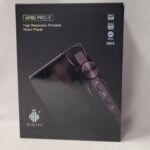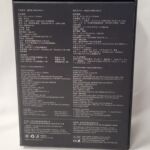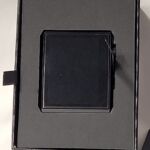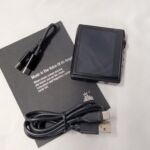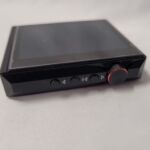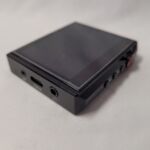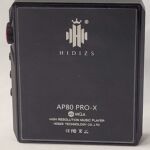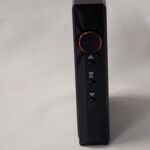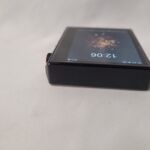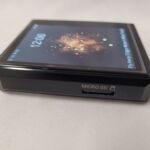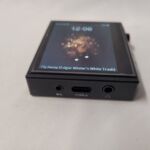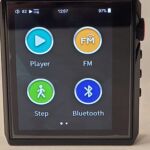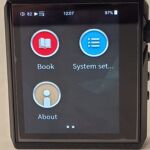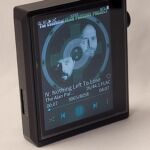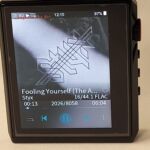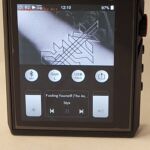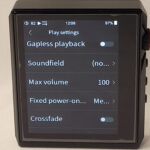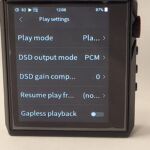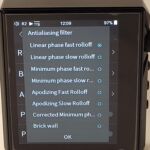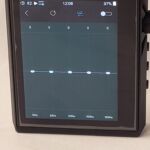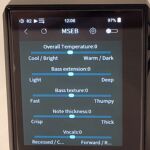Hidizs AP80 Pro X
disclaimer: The AP80 Pro X was provided by Hidizs for the purpose of this review. I have no financial interest in Hidizs and was not compensated other than the product itself. If you have an interest Hidizs, you can visit their website or their Amazon store.
Hidizs has been making DAPs since 2009 when they started work on the original AP 100. Since that time the market has grown by leaps and bounds and we’ve seen Hidizs respond with the AP60, AP200 and their most popular model to date the AP80 which arrived in 2018.
The original AP80 offered a lot of features in a tiny package. Too often those tiny packages mean big compromises, but the AP80 didn’t. It offered solid build quality, an easy to use UI, a lot of tuning options including EQ, filters and MSEB(more on that in a bit), it even offered features not seen on most DAPs like a pedometer, FM radio, and eBook reader functions. With all that going on in a package about half the size of a deck of playing cards, you’d expect battery life to be pretty limited but somehow the AP80 managed nearly 15 hours of battery life (using wired headphones) and over 8 hours even when using Bluetooth.
Add to that the fact that the AP80 sold for less than $200 USD and you had a product that was popular with audiophiles on the go and cost little enough that a lot of AP80s were purchased with the intentions of taking them hiking, biking, to the gym, giving them to teens, and use in other environments where a more expensive DAP just didn’t make sense. A lot of us that traveled a good bit also liked the size as it meant even when carrying only a day bag on the plane I could still have my music without needing a lot of additional space to do so.
Fast forward and we have now seen the AP80 released in stainless steel shell for even more durability and an AP80 Pro model that updated the AP80 for the 2020s. The AP80 Pro added DSD256 support and updated Bluetooth from 4.0 to 4.2 which may sound a bit out date but with the AP80 models supporting bi-directional Bluetooth and the differences in 4.2 and 5.0 being largely concentrated on the low power capability, it was deemed more important to keep the functionality rock solid than to move to a newer, less trusted version. The Pro also saw the addition of MQA support (4X) as well. The biggest addition to the AP80 Pro was balanced output though. While the dac remained the same in both, the output power was increased and the 2.5mm jack gave users more flexibility out of the same tiny sized package. Once again price was below $200 USD retail and the AP80 Pro sold well.
Today we have the AP80 Pro-X which is the latest update to the venerable AP80 series and it has big shoes to fill. With phones steadily encroaching on DAP sales, DAPs increasingly have become TOTL models with very high end DACs, ultra-powerful amplifier circuits, and all manner of streaming options, so an entry-level DAP that doesn’t sport any of those high end features has to rely on something else to stay relevant in the current climate.
One of the big things Hidizs leverages is price. Phones are still expensive and fragile and there are just some places most people wouldn’t take their phone. That whitewater rafting trip, bungee jumping, and hang-gliding all come to mind. For some of us, phones are broken during much more routine occurrences like softball practice, or while helping with the kid’s science fair projects. With a retail of sub-$200 USD the AP80 models are considerably less expensive than even the most basic of smartphones and thus become an option where phones dare not tread.
Another lever that can be pulled is the battery life issue with phones. While phones are improving in this regard it is still quite common to see phone reviews list battery life with heavy screen use, vs mostly audio and with Bluetooth and wireless connected vs without due to the battery consumption of those options. I first started using a DAP when connecting a Fiio E07 to my Razr phone meant I had to recharge the phone by lunch in order to keep the battery from dying. The AP80PX gives all day battery life of nearly 12 hours (3.5mm) or 8 hours (2.5mm or Bluetooth) and leaves your phone available for calls, games, text messages and all the other important stuff you bought the phone for in the first place.
The AP80PX packs dual ES9219C DACs which while not the most expensive DAC in the line-up is still considerably better than what is found in most phones. Let’s face it, phones treat audio as necessary for calls and nice for games and movies but the focus is on conservation of battery life and minimizing costs, not on fidelity. The ES9219c is a system on a chip that includes dac, headphone amp, volume control, and dynamic range enhancement , that was first introduced in late 2019, so while the Quad-DAC+ name may sound like LG ad-copy, it is as the very least an updated version. More on the ES9219c can be found here.

At this point I’ll pause to remind you the AP80PX is roughly 2 inches square and a little under ½ an inch thick and weighs just 72g. For comparison sake, a Hershey Bar weighs nearly twice that at 132g. That tiny size and low price doesn’t mean they cut corners other places either as the touch screen is a genuine Samsung part, the volume potentiometer is made by ALPs Japan, and the case is CNC machined aluminum. It is currently available in black, grey, or bright blue, and other colors have been available in the earlier models so may yet appear in the ProX.
The left side has a micro-sd card slot and while official documentation says it supports up to 512gb, I had no trouble using a Samsung 1Tb card in the test sample. On the bottom we have a 2.5mm jack, a USB type-C port, and a 3.5mm jack. The USB port can be used to load files to the player, charge the player, use the player as a source to connect to another USB DAC, or to use the player itself as USB DAC/amp from your computer or other source. Again lots of functions. The right hand side has the previous, play/pause, and next track buttons and the volume wheel and the top side is left smooth. Pressing in on the volume knob also serves as the power button.
In addition to physical controls, the AP80PX uses touch screen controls to access many of the functions of the Hiby Linux OS. Hiby Link is also enabled so the AP80PX can be effectively remote controlled from another Android or IOS device. On screen controls are large and easy to use. Powering on takes roughly 40 seconds to reach a usable state and then displays four options player, FM, step (pedometer), and Bluetooth settings. Swiping left reveals three additional options eBooks, system settings and about.
The physical buttons work once in the player, FM, or eBook apps, but most everything can also be accomplished purely by using the touch screen (the exception being powering on or off the device). Volume can be adjusted swiping up from the bottom of the screen or turning the knob with gross adjustments being faster using the on-screen control and fine adjustment easier with the knob. During playback functions, the screen sleeps and requires pushing the volume knob to reactivate the screen and then a swipe up to clear the screen saver/time display and return to the app in use. One nice thing is none of those motions disturbs the audio output so listening isn’t hindered while navigating the menus.
Most of the function buttons are pretty self-explanatory so I won’t delve into details. One thing I will note is the FM radio function uses the cable on a pair of wired headphones or earphones as its antenna so will not function without something plugged into the 3.5mm jack.
The player app is the Hiby Music App that many are familiar with as it is common to several brands of DACs and available for smartphones and tablets as well.
When you open Hiby Music, four icons are displayed at top with a track list beneath. The left most icon (hidizs symbol) opens a menu on the left with options for updating the track database, MSEB (more on this in the sound section), EQ, play settings, and exit. Choosing any of these options except database update, takes you into a full screen menu. Under play settings, the two most commonly used will likely be Play mode (shuffle), Gapless, and gain settings, but others of interest like the filters are hiding in the list if you swipe up to expose them. The four images below show the opening menu, then clicking the hidizs icon, then the two play settings screens.
Returning to the main Player menu, the second icon, musical notes, is the library functions that allows choice by artist, album, genre, etc. The third icon, the heart is favorites and playlists. And the fourth icon, the Spectrum analyzer, is the now playing option.
Once opening the now playing option, swiping up from the bottom exposes the quick controls including play controls, brightness, volume, gain, Bluetooth, USB mode, and line-out mode controls.
Connectivity options are 3.5mm and 2.5mm jacks, USB type-C, and bi-directional Bluetooth. For those of you not familiar with bi-directional Bluetooth, this allows you to use the ProX as a source with TWS earphones or use it as a Bluetooth amplifier using your phone as a source and a pair of wired earphones. Bluetooth on the ProX supports LDAC, UAT, and Apt-X which is a vast step up from the original AP80 and shows that Hidizs is keeping pace with the times.
I found connectivity quite good in open space with a range of roughly 15 meters and a single layer of drywall did little to slow it down. Exterior walls did defeat the signal easily though so the unit is best kept on your person if going outdoors. I tried using the player in my front and rear pants pockets and had no issues with signal cut outs.
On the USB side, the ProX works well as a USB DAC when connected to my laptop and while output power is somewhat limited it did a good job with headphones up to about 150Ω as long as sensitivity is kept over about 95dB/mW. This makes the ProX a most versatile package indeed.
The signature of the ProX is near neutral with a hint of brightness due to a mild mid-treble elevation. The ProX has good detail and micro-detail and with the upgrade to the latest series ESS Dac, it is a bit better detailed than the original AP80 I tested against. The AP80 has always had good dynamics and the ProX is no exception. The noise floor with super sensitive iems is still midnight black and at the same time even full sized headphones like the HD6xx have enough volume to be listenable (especially balanced). While I have no issues with the base signature of the ProX, it has a more tuning options than most high end DAPs let alone one in this price bracket. With a little tweaking, it can be neutral or deep V or L.
The DACs filter give the user 8 different options to tune the sound and can be found in the Play settings menu. Also under that menu is the SoundField option that lets the user shape the stage size and depth if desired. A multi-band EQ functions well with enough bands to allow fairly precise shaping, and if that isn’t enough MSEB offers a ton of flexibility. MSEB is a full DSP module that gives the user the ability to tune nearly every aspect of the sound
The DSP offers setting to tune temperature, bass extension, bass texture, note thickness, vocal distance, female overtones, sibilance (both high and low filters), impulse response, and air. The Hidizs DAPs are among the most tunable out there.
While many today debate the need for any DAP, the Hidizs AP80 Pro
X packs enough versatility and a low enough price that many will find it makes good sense even in this age of streaming from your phone. It offers enough battery life for all day use, can be used as a USB Dac/Amp with your laptop or PC, as a Bluetooth amplifier to pair with your phone, and when used as a file player it offers the user more sound customizations options than most other DAPs and phone apps. There is a lot to like and the price and this would make a great first DAP for those looking to see what they are all about, a great backup DAP for those who are already well entrenched in the headphone lifestyle, and a good present for the youngster who wants a DAP but may be hard on one. I liked the original AP80 and can say that the few complaints I had have been resolved in the AP80 ProX. As a result the Hidizs AP80 ProX easily gets my recommendation.


